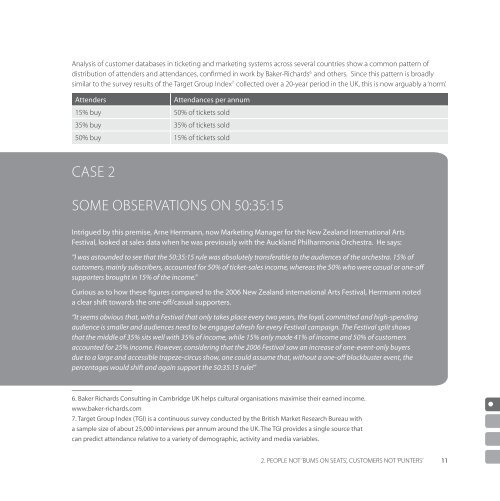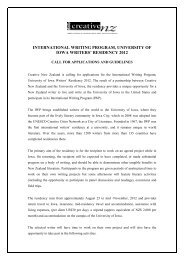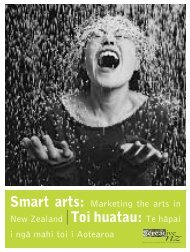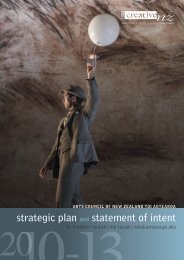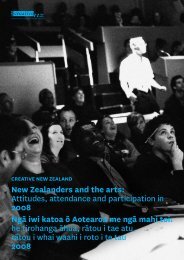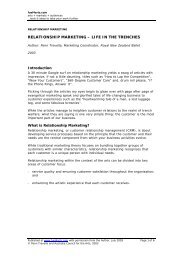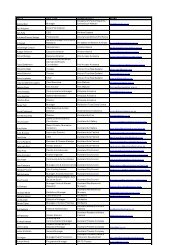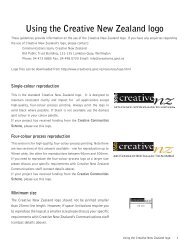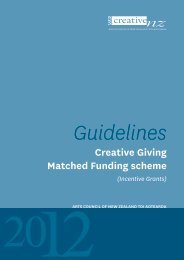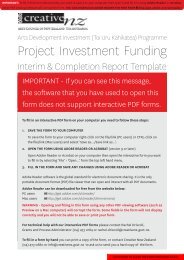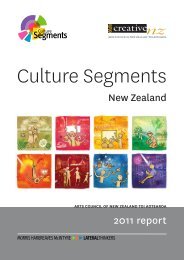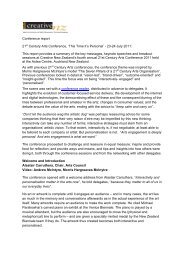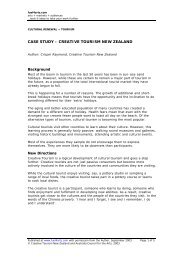FULL HOUSE Turning Data into Audiences - Creative New Zealand
FULL HOUSE Turning Data into Audiences - Creative New Zealand
FULL HOUSE Turning Data into Audiences - Creative New Zealand
Create successful ePaper yourself
Turn your PDF publications into a flip-book with our unique Google optimized e-Paper software.
Analysis of customer databases in ticketing and marketing systems across several countries show a common pattern of<br />
distribution of attenders and attendances, confirmed in work by Baker-Richards 6 and others. Since this pattern is broadly<br />
similar to the survey results of the Target Group Index 7 collected over a 20-year period in the UK, this is now arguably a ‘norm’.<br />
Attenders<br />
Attendances per annum<br />
15% buy 50% of tickets sold<br />
35% buy 35% of tickets sold<br />
50% buy 15% of tickets sold<br />
Case 2<br />
Some observations on 50:35:15<br />
Intrigued by this premise, Arne Herrmann, now Marketing Manager for the <strong>New</strong> <strong>Zealand</strong> International Arts<br />
Festival, looked at sales data when he was previously with the Auckland Philharmonia Orchestra. He says:<br />
“I was astounded to see that the 50:35:15 rule was absolutely transferable to the audiences of the orchestra. 15% of<br />
customers, mainly subscribers, accounted for 50% of ticket-sales income, whereas the 50% who were casual or one-off<br />
supporters brought in 15% of the income.”<br />
Curious as to how these figures compared to the 2006 <strong>New</strong> <strong>Zealand</strong> international Arts Festival, Herrmann noted<br />
a clear shift towards the one-off/casual supporters.<br />
“It seems obvious that, with a Festival that only takes place every two years, the loyal, committed and high-spending<br />
audience is smaller and audiences need to be engaged afresh for every Festival campaign. The Festival split shows<br />
that the middle of 35% sits well with 35% of income, while 15% only made 41% of income and 50% of customers<br />
accounted for 25% income. However, considering that the 2006 Festival saw an increase of one-event-only buyers<br />
due to a large and accessible trapeze-circus show, one could assume that, without a one-off blockbuster event, the<br />
percentages would shift and again support the 50:35:15 rule!”<br />
6. Baker Richards Consulting in Cambridge UK helps cultural organisations maximise their earned income.<br />
www.baker-richards.com<br />
7. Target Group Index (TGI) is a continuous survey conducted by the British Market Research Bureau with<br />
a sample size of about 25,000 interviews per annum around the UK. The TGI provides a single source that<br />
can predict attendance relative to a variety of demographic, activity and media variables.<br />
2. PEOPLE NOT ‘BUMS ON SEATS’, CUSTOMERS NOT ‘PUNTERS’<br />
11


